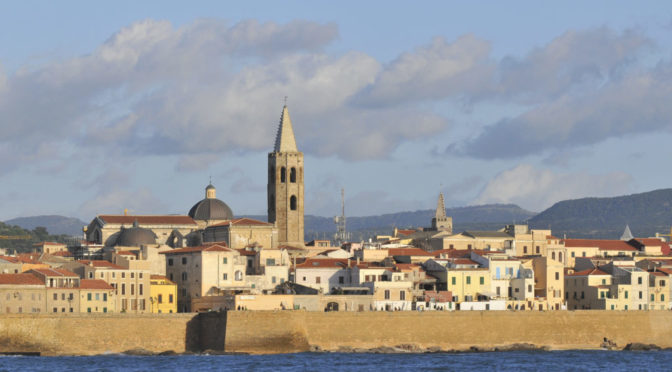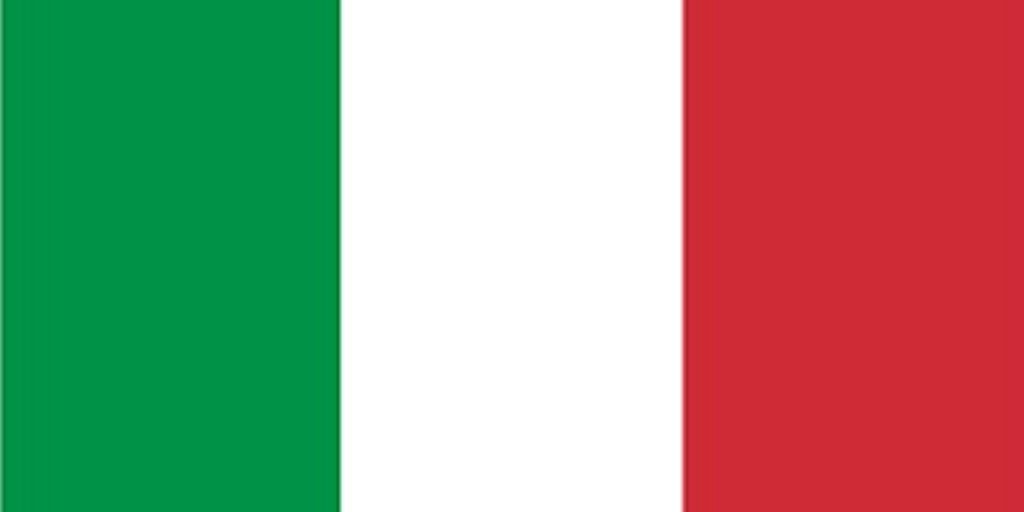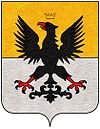Alghero year of foundation it is not well defined, the most plausible is 1102 (G. Manno: Storia della Sardegna), settled by the Doria, a Genoese family, who initially populated Alghero with a small group of Ligurians.
Around the origin of its name, there is no certainty either: the most logical one is the one that finds its reason in the word ‘seaweed’, in Italian alga (aliguerium), a very common aquatic plant in the whole Alghero’s marine area. The vast area around the town and the near plain Nurra was definitely populated since millennium: several necropolis and nuraghe are a proof of it. The Necropoli of Anghelu Ruju and the Santu Pedru one in the town urban area deserve a special mention. At the end of the XVII century after a census, the enumerated “nuraghi” were 100 circa, around Alghero and the whole Nurra. Another important remark, thanks to its size and preservation, goes to the Nuraghe Palmavera. There is, on the contrary, a lack of information about romans domination, except the Villa of Sant’Imbenia, in Porto Conte.
In the Middle Age, after the fall of the Western Roman Empire (476 A.D.) and at the end of the Byzantine time, Sardinia chose a form of auto-administration named “Giudicato” with headquarters in Cagliari, Arborea, Torres and Gallura (IX-X sec.). The area of the unborn Alghero was integrated in the Torres district.
In 824 A.D. Pope Pasquale I, assigned the title of Protector to Count Isidoro, member of one of the most important family in Logudoro. Apparently, Count Isidoro gave a valuable help to the Sardinian judges in the fight against the Saracen hordes who attacked the Sardinian coasts. It was then that the Capo Caccia natural harbour, called “porto Ninfeo”, was renamed “Porto Conte” (from Michele Chessa historical studies in “Racconti Algheresi”).
Between XI and XIII century Sardinia experiences a strong influence from Pisa and Genoa, both engaged in the fight against the persistent Saracen pirates attacks to the island.
In 1102 the Doria family starts the construction of the fortress in Alghero, giving birth to what will become one of the most important Sardinian cities.
In 1248 after a siege of 28 days, Pisa occupied Alghero, defeating Genoa, for the predominance of the island.
Four years later the city returned under the Gonoese control, after Genoa’s victory against Pisa in the battle of Maloria.
In 1353 Alghero was conquered, for a short lap of time, by the Kingdom of Aragon fleet, its admiral Bernardo Cabrera and its Vanetians allies. After a few days though, Cabrera was sailing towards Cagliari and the people of Alghero, “Algheresi”, raised up against the Aragonese garrison and gave back the city to the Doria.
In 1354, after a siege of four months, the Aragonese got the control of the city back. The year after King Pietro IV gave orders to repopulate Alghero, with family coming from Catalonia and declared the city united to the Crown of Aragona, awarding it with a new emblem.
In 1360 King Pietro arranged the transfer of the Jewish community, banished from the Spanish states in 1492.
In 1384 King Pietro fostered the coral fishing, started some decades earlier by the Marseillese fishermen.
In 1460, after an umpteenth attempt of occupation by the Genoese, King Giovanni II ordered the expulsion from Alghero, of all the foreigners present there to work and trade; he also forbad marriages between people from Alghero and Sardinian, French, Genoese and Corsican for security reasons.
During the XV century the Saint Frances church was built and a couple of years after Saint Mary Cathedral too.
In 1501 King Ferdinando the Catholic promoted Alghero to a ‘City’ rank.
In 1541 Carlo V visited Alghero, guest in the house of Pietro de Ferrara in the present-day Piazza Civica (You can find a detailed description of his visits in Johan Galeaco’s report, notary of the city at the time).
1582 was a tragic year for Alghero, as Tonino Budruni reports in its book “Breve storia di Alghero”. On November 19th the nightmare revealed itself in all its cruel dangerousness, when Doctor Quinto Tiberio Angelerio was called to assist a seriously sick woman; he got to know that illness a few years before in Messina, during an aggressive plague epidemic. The Doctor warned immediately the authorities, but had to face the scepticism and ignorance of people who feared for the business trade closure. They became aware of the importance of the matter at last: around Alghero’s borders three sanitary cordons were established, with soldiers preventing people to come in or go out of the city. Alghero suffered terrible losses, both economic and human.
In 1583 (end of the plague), a slow, but progressive re-population started by the citizens coming from nearby, together with the economic activities.
Twenty years later Sardinian surnames were, by now, fully higher than the Catalan ones, even though these ones, despite being a minority, kept holding the political power, and Catalan remained a spoken and taught language.
The 1589 census registered 4000 residents. The 1627’s one registered 5000 citizens.
1652: The black plague. One day, in May, after a corruption act, the disembarkation procedures were not respected and a mercantile ship docked in the port. The seamen and goods of that ship were infected and the plague spread rapidly. The loss counted up to 3000/3500 people out of 5000 total citizens. During those dreadful months some of the most beautiful nobility Catalan names disappeared.
Repopoulation of the city After the plague, new privileges were granted to citizens and new family units came back, Sardinian in majority, then Spanish and Ligurian. In XVII the Sardinian ethnicity was the 70% of the total, Ligurian 20% and Catalan the 7%.
1708: With the Utrecth peace treaty, Sardinia goes under the Austrian domination.
1717: The Spanish occupy Sardinia again. After three days of siege, Alghero falls. The year after the London treaty, Sardinia was returned to Austria.
1720: Austria gives up Sardinia to the Savoy. This determines the end of the Spanish domination. The city counts 4.500 people and will keep the Catalan language together with several religious traditions until present time. In the following years, the city walls were reinforced, the coral fishing and the cultivation of olive tree were subsidized.
1722: cholera was a threat, therefore a leper hospital was built in Capo Galera to isolate the sick ones, but only a few ruins have survived until today.
1739: the first Post Office opens up in Alghero. A census of that year registers 5116 citizens.
1786: Giuseppe Manno comes into the world in Alghero. He studies in town and then moves to south, Cagliari, where he graduated in canon law in 1804. Next, he moved to Turin, after a brilliant career in the public administration, in 1848 he was elected Senator of the realm, to become then President from 1849 to 1855. He was also a gifted historian and wrote, between 1825 and 1827, “Storia di Sardegna” and in 1842 “Storia moderna della Sardegna”.
01800: Vincenzo Sulis, a patriot from Cagliari, was sentenced to life imprisonment for conspiracy. He was interned in the Sperone tower. Twenty-one years after he was pardoned by the King and confined in the island Maddalena.
1829: King Carlo Alberto visits Alghero.
1846: A new census, the city counts 8716 inhabitants.
1848: first town elections with Giovanni Battista Garibaldi first mayor.
1855: Opening ceremony of the Porta Terra Public Gardens.
1857: King Vittorio Emanuele II visits Alghero.
1862: Opening Ceremony of the civic theatre.
1899: King Umberto I and Queen Margherita in visit to Alghero.
1899: Erminio Sella and Edgardo Mosca found the Sella & Mosca wine-producing company.
Sella&Mosca Estate
1912: Alghero’s water main starts working.
1920: thanks to the entrepreneur Enrico Valsecchi Alghero gets its public lighting.
1934: the construction of Fertilia begins.
1937: from Porto Conte seaplane base the first seaplane takes off.
1938: opening ceremony of the military airport.
1939: the construction of the Tramariglio penal colony begins with a project by the engineer Arturo Miraglia. That colony was closed on 1961. After the realisation of Porto Conte’s natural park some of the buildings got back to a public use.
1943: Alghero was bombed twice, causing a hundreds of dead.
1946: Referendum: Monarchy-Republic. The city manifested its preference for the monarchy. During those years Alghero counted about 17.000 citizens.
English version: Francesca Sanna


